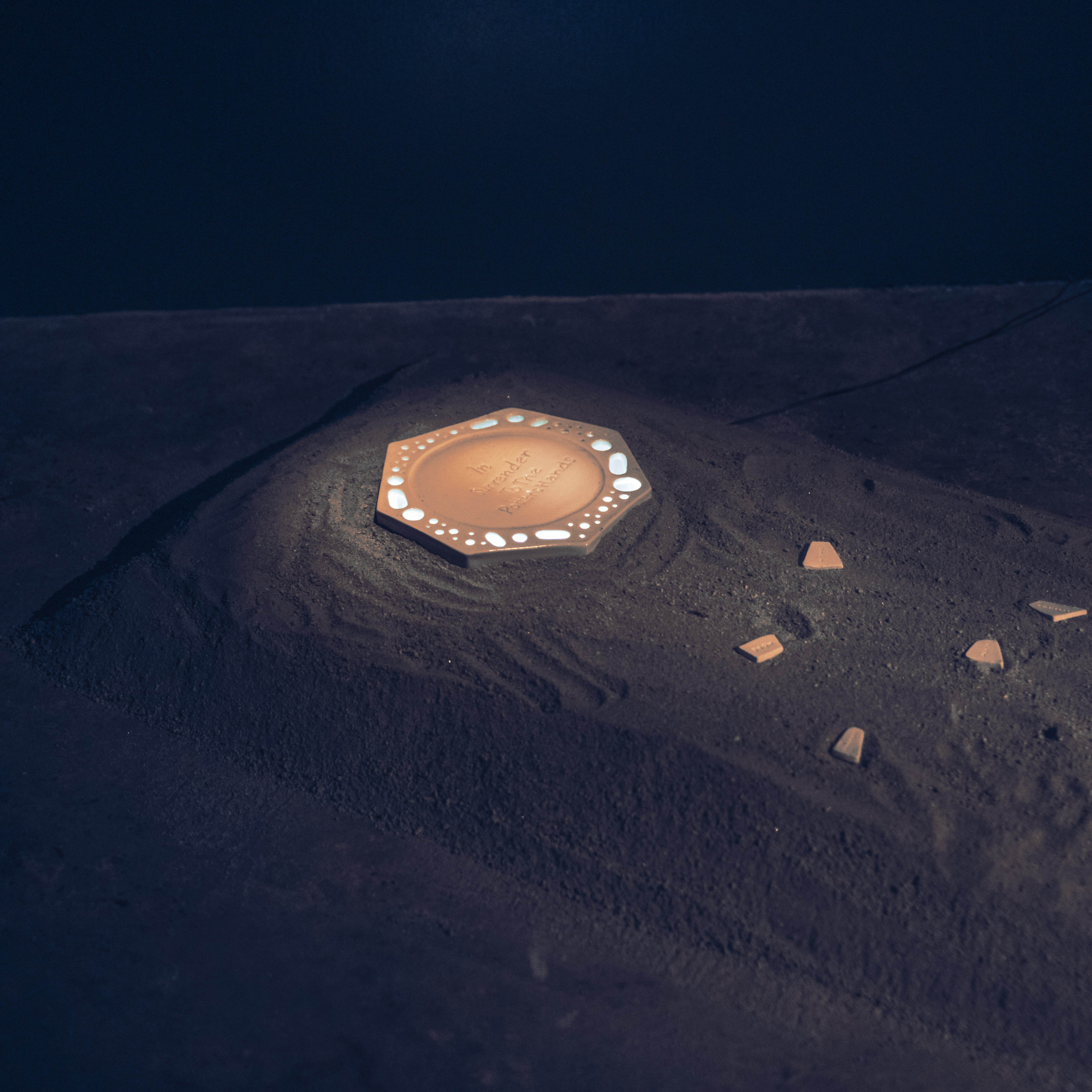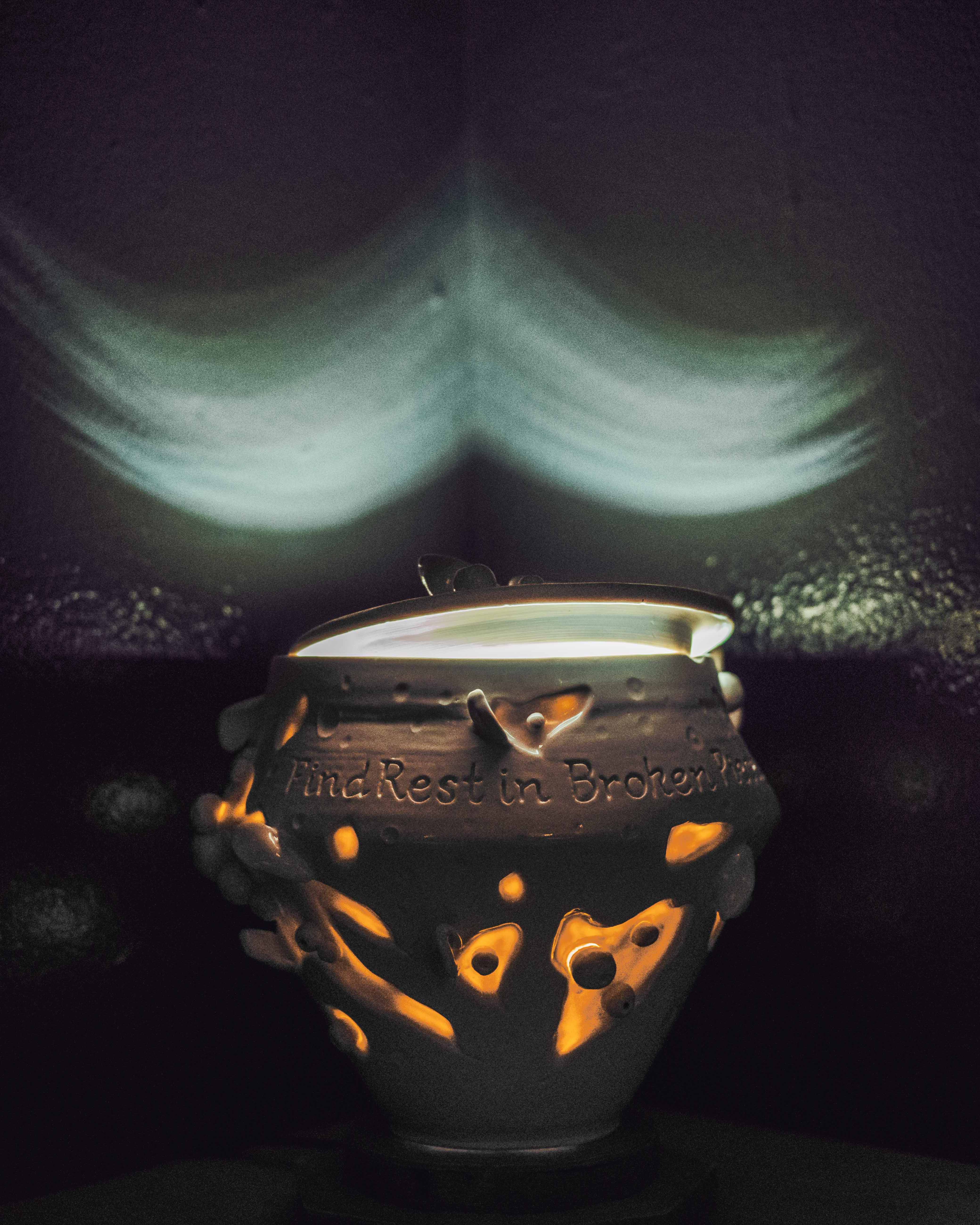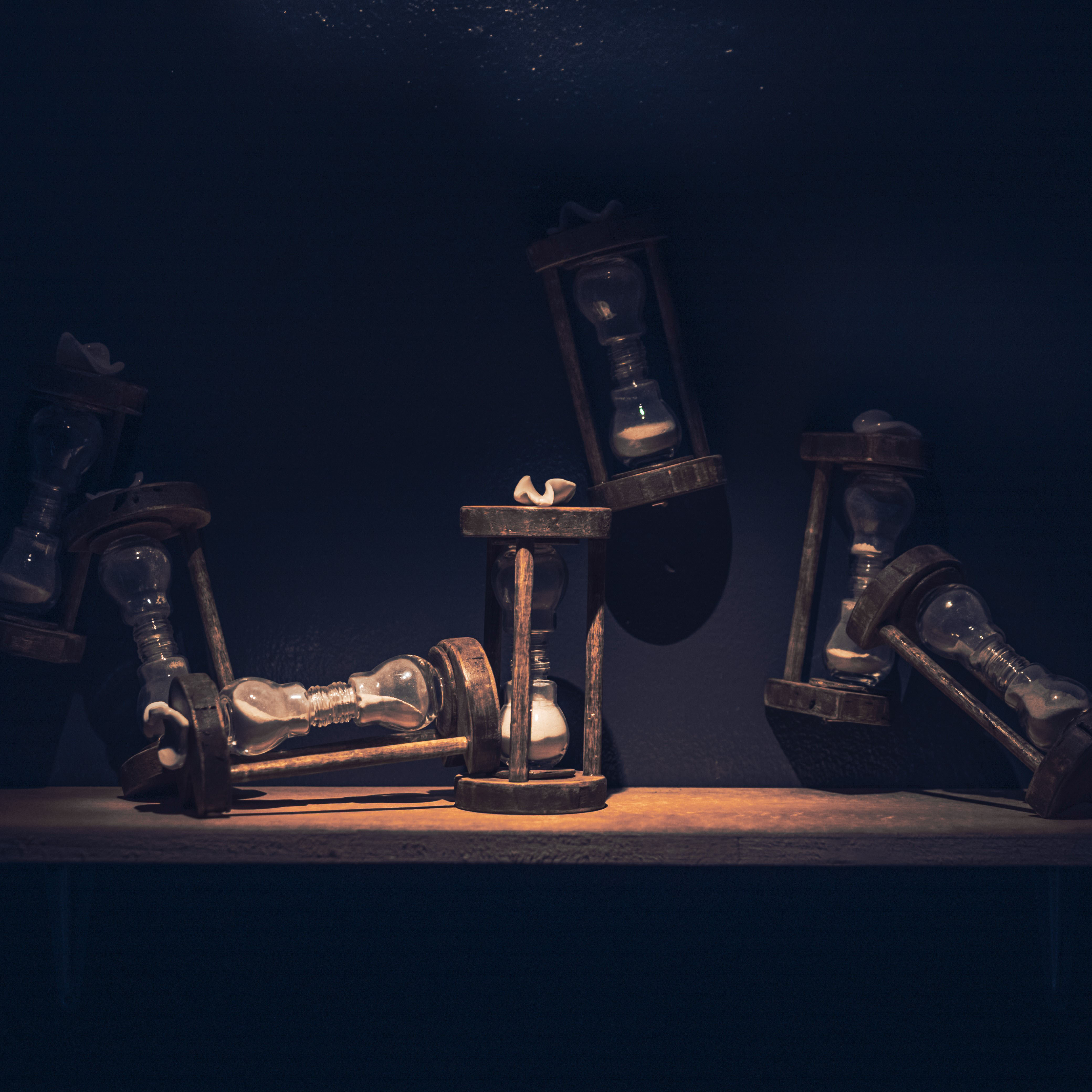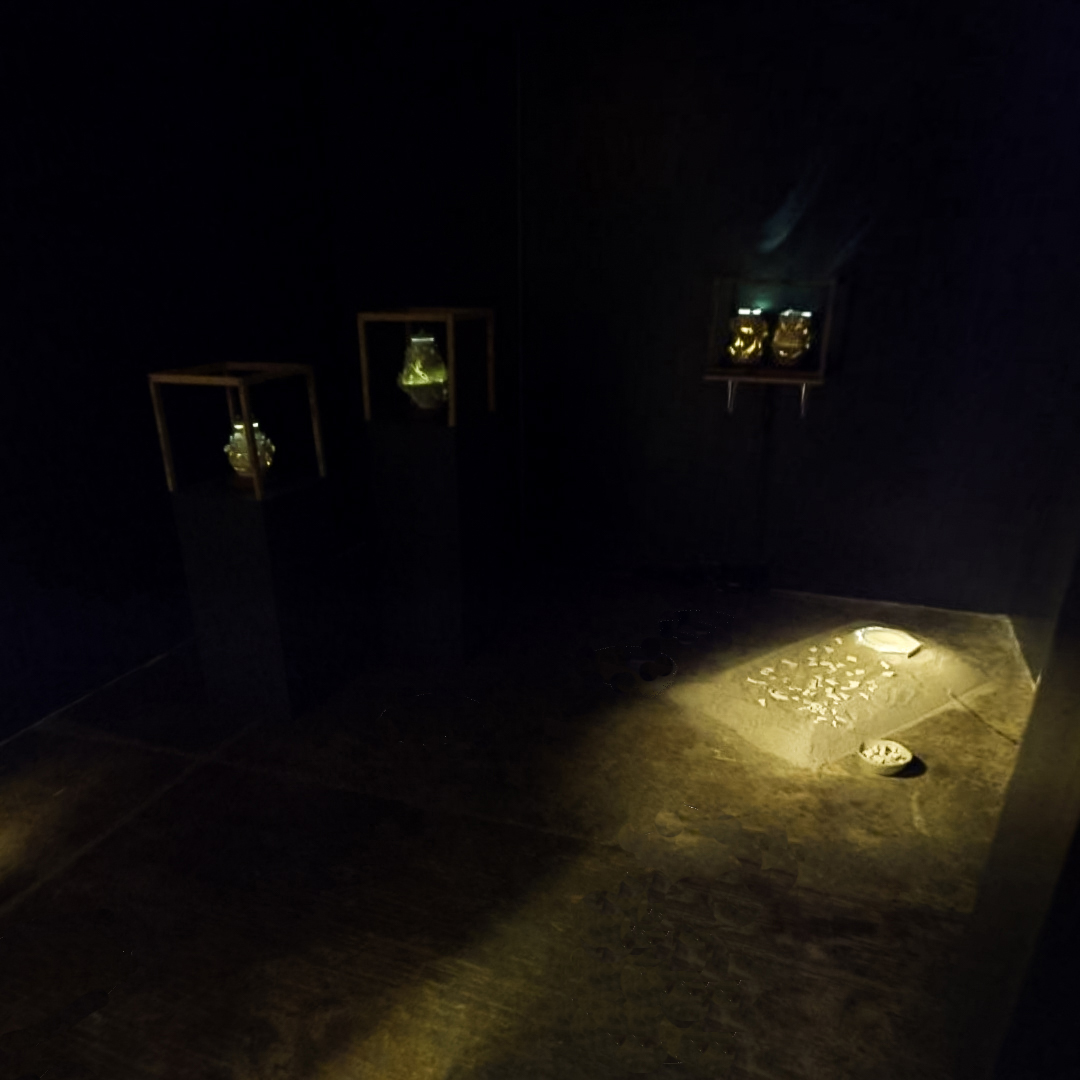A memorial slab is nestled on a mound of dust on the floor. Seven urns sit on pedestals around the room, each engraved with epithets reminding the mourner of human fragility. Fine porcelain dust sifts through seven hourglasses, as time drains down through the gap. Confronted by these images of mortality, how does one make peace?
After months of grinding production, the flurry of preparation, and even years of conceptualization, Stephen Lucio sits down to reflect on this question a couple of weeks after mounting his first solo show, When the Dust Settles at Vinyl on Vinyl.
When the artist talks about his process, he always comes back to the idea of dust. Nearly the whole installation is created from this one material. Hydrated porcelain dust molded into a form, glazed, and fired. Playing through the room is an atmospheric, instrumental track spliced with the sound of hardened clay being crushed back into dust. Drawing parallels between human life and this cyclical process of molding and breaking down, Lucio says, “That’s where we end up after everything. We go back to whose we are, to who made us.” All life will end in dust.
This parallel continues with the inscriptions etched on the porcelain urns, intertwining mortality with ceramic making—"The Wheel Has Come Full Circle", "Forever Humbled by Your Cracks", "Score and Slip Together and Always", ”In Flaming Memory”. On one in particular, “Find Rest in Broken Pieces”, Lucio says, “Usually, when you’re a potter, or ceramicist, even the very experienced, you don’t hold [the process]. The medium is very unpredictable. After the process of firing, there are usually a lot of cracks. However experienced you are, you would still experience these cracks and breaks.” Lucio then shares that this acceptance of broken pieces struck viewers as comforting in the midst of the temperamental aspects of life.
Lucio opens the exhibit partly as a memorial. He says, “I have friends with close relatives who have died. They weren’t able to attend funerals or arrange a proper funeral because of the pandemic. We weren’t allowed to hold mass gatherings.”
“When I create, I like having a lot of layers—not to simply put up sculptures.” During the opening, guests were invited to participate. Lucio explains that the shards etched with words such as ‘hope’, ‘strength’, or ‘peace’ can be tossed on the grave slab, offered as a prayer, harking back to the practice of tossing flowers onto a lowering casket.
Lucio is no stranger to these themes of life and death, especially through exploring the subject of illness. His undergraduate thesis, Enlightened, (now housed in Pintô Art Museum), tackled his personal experience with epilepsy. Breaking the Mythical Chain is a series that aimed at demystifying superstitious beliefs about disease by taking a scientific approach. Come and Talk to Me came at the height of the pandemic to create awareness and appreciation for medical front liners. But after presenting these themes, the artist wanted to push for more.
“After I fell really sick, after my thesis, I gravitated toward the theme of mortality. That was my take-off point for what I wanted to do with the medium that I wasn’t able to during my thesis, and how I wanted to improve it. [...] Before, [I was more focused] on science; I used scientific designs and forms. Moving forward, I want to add in the coexistence of science and spirituality.”
Speaking on the spirituality from which he pulls his art, he continues, “During the pandemic, I was able to reconnect with my faith. [I] rediscovered my spirituality and relationship with the Lord.” After presenting the objective truth of ashes in a jar, he finds its complement—a hope of something beyond. Though urns, the vessels glow with life. Lucio focused on the translucency of porcelain, allowing the pieces to be lit from within. Through this lens, the hourglasses do not seem as ominous—not a countdown toward decay, but toward rest. “Someone told me during the opening that [the show] isn’t emotionally heavy. Even though I’m tackling death and mortality, they see hope and light. There’s contrast there; at the end you see light, hope, pointing everything to God.”
Through this, Lucio makes peace with his mortality. A bedrock for his work is a verse from the book of Isaiah that says, “give unto them beauty for ashes, the oil of joy for mourning, the garment of praise for the spirit of heaviness”, allowing him to transform these images of death into something hopeful, through the personal hope he holds onto. He continues, “Now that I’ve been pondering on this [the show’s theme], I read the book of Ecclesiastes, which is all about dust. That Bible book is incredibly depressing. [...] At the same time, in the end, the author points out that the Lord would return. He’s the hope that we can rely on. Upon pondering the dust, we are not merely dust, we are way more. It’s a more spiritual thing. There is a spirit within us.”
The central memorial slab reads “In Surrender to the Potter’s Hands”. When the Dust Settles does not demean surrender. To surrender to the grave, to allow the self to be malleable as clay, to be molded by something other than one’s own will, to admit to shortcomings, is not weakness. Lucio shares his own dependence that influenced this, saying, “I decided, ‘Lord, whatever you want to happen to my career, family, or health [...] [I] trust that you will handle anything that could happen to me, even the unpredictable. [...] If I don’t [practice this dependence], I know that something will happen in terms of my health. My body gives up. That’s how I held on. Besides death, anything that I might worry about, [I’m] in total dependence, in total surrender.”
Out of Lucio’s patience with molding the medium, an attitude of allowance for brokenness, for healing, for growth, seeps into the installation. It offers a glimpse of light in the darkness. It memorializes not mere ash, but the spirit that transcends the dust.
When Dust Settles continues until May 10 at Vinyl on Vinyl in Makati City.
Shireen Co is an artist, experimental cook (of leftovers), and mid-range chess nerd. Tap the button below to buy her a coffee:




